
--THE TALMUD OF JMMANUEL-- ( with Updated History)
THIS IS THE FULL TEXT OF THIS DOCUMENT IN PDF FORMAT:
http://fourwinds10.com/journals/talmud/talmud.pdf
Fourwinds thanks John Grau (johng1400@yahoo.co.uk),who gifted this document to us
. His website is \'Sign of Jonah\' at http://www.signofjonah.co.uk
[The Talmud of Jmmanuel are the original teachings of Esu (Jesus) Immanuel of 2000 years ago, as recorded by Esu Immanuel\'s disciple, scribe and closest friend, Judas Iscariot, one of the twelve disciples. These writings were preserved by Esu\'s son Joseph, who carried them back from his home in India at Esu\'s death, and placed them in the Tomb of Aramathea in Jerusalem, where Esu had lain at the time of his crucifixion.
In 1963 Eduard Albert (Billy) Meier and his friend ex-Greek-Orthodox priest, Isa Rashid, recovered these four scrolls, where they had been buried for 2000 years. Rashid translated the first scroll of 36 chapters from Aramaic into the German language of Meier. Rashid\'s work was interrupted when Israeli authorities discovered his work in Jerusalem. Rashid fled with the scrolls to a Lebanese refugee camp, but the Israeli Military bombed the camp, forcing him to flee to Baghdad. Because the scrolls were either destroyed in the bombing or they fell into Israeli hands,the remaining three were never translated, and their message was lost to the modern world. PHB ]
******************
Discovery of the Talmud of Jmmanuel (TJ)
From: http://www.tjresearch.info/discovery.htm
This discovery occurred in 1963 as Swiss citizen and then world-traveler, Eduard Albert Meier, and his older friend, an ex-Greek-Orthodox priest, Isa Rashid, were walking along a roadway just south of the Old City of Jerusalem late one afternoon. Meier happened to glance up the slope and notice a small opening in the ground amongst the rocks and shrubs. According to Meier\'s much later recollection in August of 1997, this hole was about 30 cm, or a foot, on a side. Being curious, he reached into his packsack for his flashlight and peered into the hole to notice that it continued inwards. So he and Rashid proceeded to dig away rocks and earth until the hole was large enough that they could crawl inside. It was an old tomb site, half filled in with earth. After further digging and exploring inside it they discovered, buried underneath a flat rock, a bundle which they took back with them to Rashid\'s abode; it was about 60 cm in length and 25 cm wide. The bundle turned out to contain the Talmud of Jmmanuel (or TJ) in the form of rolls of written sheets, along with a few small artifacts. They had been wrapped up together in animal skin which was in turn encased in resin, by then dry and crumbly, but recalled to have been black on the outside and yellowish-brown on the inside. There were four rolls, each of which contained many leaves or pages of Aramaic writing. They were obviously old and fragile but the writing was clearly legible. Meier recalls that each leaf was roughly 30cm by 40cm in size, or somewhat larger than the European AID A4 size of paper, which is 21cm by 29.4cm. He is not sure if they were made of very thin, translucent parchment or of papyrus.
Rashid, who could read most of the old Aramaic due to his Palestinian background on his father\'s side, soon noted that the TJ was heretical in several respects. For one, its title involved Jmmanuel (i.e., Immanuel, spelled with a J symbol supplying the "i" sound in place of the Aramaic/Hebrew letter "Ayin") rather than Jesus or Y\'shua. For another, its writer was given as Judas Iscariot, the supposed betrayer. For a third, it mentioned that Adam\'s father had been Semjasa, the leader of the celestial sons, who were El\'s or God\'s guardian angels, and who were "distant travelers." Thus it was apparent from the beginning that if they wished this document ever to become public, its translation would have to proceed in secret. The Old Testament God had been an extraterrestrial leader rather than a "Father" in heaven. We shall be referring to him by his title of El, as in Immanuel.
Meier\'s interest in the document was very strong, as he not only had been self-schooled in earth\'s major religions while working his way around Asia and the Mideast, and was seeking spiritual truths, but he had been informed seven years before that he would become the disseminator of this document (more on this in the following section). Rashid spent a few months reading through the TJ rolls to glean their highlights, which he reported to Meier. Then the two agreed in August of 1963 that Rashid would translate the TJ into Meier\'s language (German, a language which Rashid understood) and would retain custody of the Aramaic document, while sending his translations to Meier for him to disseminate. So Rashid started the long task of rendering a translation of satisfactory quality, while Meier then continued his travels and first-hand religious learning, particularly under a Hindu guru at the Ashoka ashram in Mehrauli, India, working his way along through doing odd jobs. The 1964 New Delhi newspaper article about Meier can be read here. In 1965 Meier lost his left arm in a bus accident in Turkey. Later that year he met a Greek girl, Kalliope, eloped with her in 1966 and, after further working/traveling their way around Asia, returned to Switzerland to continue raising a family there and obtain employment in the town of Hinwil.
The translations up through the TJ\'s 36th chapter reached Meier in Switzerland through circuitous mail some time around 1970. They had been sent to the address Rashid remembered for Meier\'s parents. But Meier did not hear from Rashid himself until in a letter in September of 1974. This letter briefly explained that his translation project had become known to certain authorities, forcing him to flee from Jerusalem, together with his family, the TJ rolls and further translations, to a refugee camp in Lebanon. But his presence there became known to Israeli authorities, and the camp was heavily bombed, forcing him to flee again, this time to Baghdad, where he posted the letter to Meier. However, he and his family, like the other refugees, had to flee so suddenly that Rashid had no time to retrieve the Aramaic rolls or his further translations of them, and they were destroyed in the resulting conflagration.
In 1976 Meier learned that Rashid and his family were assassinated in Baghdad, making him (Meier) the only known surviving witness to the TJ\'s discovery and historicity. About this time he started preparing the TJ translations for self-publication, and the German edition came out in 1978. A combined German-English version was published in 1992, and another edition, with improved English translation, was published in 1996 by Wild Flower Press. A further improved German-English translation, the TJ\'s 3rd edition, came out in November of 2001, and a 4th edition, further improved, is due out in 2006 from its new publisher, Steelmark. Meier insists that publications of non-German translations of the TJ include the side-by-side German edition, so that discrepancies or distortions in translation be less likely to creep in.
Go here (http://www.tjresearch.info/discovery.htm)for an excellent article introducing the TJ and its co-discoverer, Eduard Meier.
**********************
Overview of the TJ
From: http://www.tjresearch.info/overview.htm
The translation of the Aramaic leaves of the first roll reads as if it is the original writing
of the ministry and teachings of Jesus. However, it indicated that his original name was not Jesus, but had been Immanuel. His desire to have it be spelled starting with a "J" symbol is explained in Meier\'s Foreword to the TJ. The New Testament gospel most closely resembling the TJ is the Gospel of Matthew. It resembles the TJ closely in both wording, where the verses have close parallels, and in order, although each contains much text not contained by the other. Since 1986 I have been analyzing this Talmud and finding several hundred reasons consistent with its verses having been genuine and Matthew\'s verses having been derived from them.
It is impressive that despite this close similarity between the two texts, the TJ contains its own theme?a no-frills New Age theme in its essence that is absent from Matthew except for traces left behind. The TJ gives its own story in a straightforward manner that is remarkably free from inconsistencies, ambiguities and interruptions in flow of thought, all of which scholars have found characterize Matthew many times over. Comparison of the two texts allows one to deduce which of Jmmanuel\'s teachings had to be altered or omitted to conform with the early Christianity that Paul had initiated, and which teachings of Jmmanuel managed to find their way into the Gospels almost intact. A summary of these teachings is presented here. Unfortunately, his teachings that were carried forward into Matthew essentially unaltered are in the minority. Comparison of the two texts leads to consistent reasons why the writer of Matthew made the changes he did.
The spiritual message of the TJ, which is its main thrust, is both enlightening and inspiring for one whose belief system does not oppose certain basics of New Age thought. It is described in an internet article, whose source appeared in Wildfire magazine (vol. 4, No. 2; 1989), which I authored. I discuss the spirituality of the TJ further in the July issue (vol. 15, No. 3) of the J. of Religion and Psychical Research.
Basically, this theme involves discussions of the human spirit, its gradual evolution over innumerable lifetimes, its immortality and its eventual merger with and into the Great Spirit or Universal Consciousness or God, which the TJ refers to as Creation. A related theme teaches the distinction between human-like beings much advanced over us (called guardian angels and celestial sons), and Creation; these beings are of course commonly referred to as extraterrestrials (ETs) or aliens today. Their leader, for whom Jmmanuel had great respect, is referred to as "Gott" (God) in the German translation but as El here, since the Aramaic word, "El," as in "Immanuel," is what was used to refer to this entity. However, "El" in the Old Testament is translated as "God," which then was the procedure followed by the TJ\'s translator.
The overarching motif surrounding the TJ is that a certain alien group, who told Jmmanuel they were from the constellation of the seven stars?the Pleiades, were genetically compatible with us and had been visiting Earth in past scores of thousands of years. Some 10,000 or so years ago they decided to oversee us in a manner that no longer involved themselves directly, and to give us some guidance in a similar indirect manner. This they did by arranging to have a highly advanced soul periodically reincarnate into the human race in the Middle East region, starting with the biblical Enoch. Some 3000 years ago they decided the time was approaching when the key human lifetime of this soul should occur, for the purpose of teaching humanity some spiritual truths. So some 2000 years ago they brought about this incarnation, with that soul reincarnating into the fetus of Jmmanuel around A.D. 6, not 6 B.C.! His alien procreator saw to it that Jmmanuel would receive intensive education in his youth, which involved those "lost years of Jesus" spent in India -- a topic receiving very substantial evidential support. Thus Jmmanuel was an occasional contactee of these aliens. They realized that his teachings would inevitably be distorted, but felt that mankind could only learn through making mistakes and then learning from those mistakes. So they maintained a continued interest over the centuries.
One of the TJ\'s minor heresies is that the person who betrayed Jmmanuel to the arresting party and a little later committed suicide was Juda Ihariot, a young Pharisee who had been acquainted with Jmmanuel and the disciples, and not Judas Iscariot. Judas was Jmmanuel\'s designated writer as well as the treasurer for the twelve.
However, the greatest of the TJ\'s heresies is that he survived the crucifixion, with the help of medical attention inside the tomb during three days and nights. Then, after appearing to his disciples several times, he went on to Damascus where he stayed incognito a couple years, before sending for his mother Mary, brother Judas (Judas Thomas) and disciple Judas Iscariot to join him. Soon thereafter they started on their travels, of which various traditions speak.
The TJ rolls were mostly written by Judas Iscariot who traveled with Jmmanuel to India, along with Judas-Thomas (Jmmanuel\'s brother Judas) and mother Mary, several years after the crucifixion. However, the full story was only completed in India in the early second century, with a transcription of the rolls apparently having been penned there. After Jmmanuel\'s eventual death in the Kashmir region in early 2nd century, the rolls and their transcription were carried back to the Palestinian or Anatolian region by Jmmanuel\'s oldest son. He evidently released the transcription somewhere in that region, where it eventually found its way into the hands of the writer of Matthew, but he preserved and hid the original TJ rolls within a tomb just south of the Old City of Jerusalem. There they were presumably safeguarded from premature discovery by aliens of the same group until they prompted Meier and Rashid to discover them in 1963.
Early in his Pleiadian contacts Meier asked his primary alien contactor, Semjase, if she could give him a picture of Jmmanuel. She declined, but told him that if he supplied paper and pencil (so that no alien evidence would be left behind) she would make a sketch from their records. This she did, and gave to Meier; it is shown on the left. He is seen to be young looking but bearded, with almond-shaped eyes, hair parted in the middle, a mustache and lips that are not especially prominent. These same features are seen in the picture on the right, which is an etching on a stone that came from the Burrows cave in Michigan containing various native-American artifacts. The latter did not come to public attention until 1879, and were recently dated to the 4th century A.D. or earlier (Wayne May, "Christ in America?," Ancient American, Vol. 4, No. 26 (Jan./Feb. 1999)). (The face shown in these drawings does not much resemble the one on the Shroud of Turin.) Considering that Jmmanuel was a contactee whose mission was to teach spiritual truths in many lands, we must keep open the possibility that some time after traveling to northern India and settling down there, Jmmanuel was taken on extended tours to the Americas and back in his father\'s UFO. See He Walked the Americas by L. Taylor Hansen (Amherst, WI: Legend Press, 1963), for Native-American legends regarding "Jesus," as influenced by Christianity in the last few centuries. Interestingly, both the stone etching and the legends indicate the man had a full beard, which Native Americans did not grow.
The TJ\'s text continues well into the narratives of Jmmanuel\'s travels in Anatolia, with interesting and practical teachings occupying much of it. Then it ends due to Rashid\'s written translation of the rolls not having extended past the point where Jmmanuel and his traveling companions were in a caravan on the road headed east to the land of India. Meier has estimated that only one of the original four rolls of writing was translated before their destruction in 1974. Thus, all has been lost that pertained to Jmmanuel\'s long life and ministry in India and Kashmir, except for what Rashid read during his initial reading of the rolls and then related to Meier, and except for what certain other traditions indicate.
What was not lost, however, includes a wealth of extremely valuable material. Among it is confirmation that Jmmanuel alias Jesus did travel to India and back during the Lost Years of his youth and early manhood. This confirms research on this topic, the most recent of which is that of Ed Martin, author of King of Travelers.
********************************
Jan. 31, 201
OVERVIEW OF THE TALMUD OF JMMANUEL
The translation of the Aramaic leaves of the first roll reads as if it is the original writing of the ministry and teachings of Jesus. However, it indicated that his original name was not Jesus, but had been Immanuel. His desire to have it be spelled starting with a "J" symbol is partially explained in Meier's Foreword to the TJ: it was to honor the Plejaren extraterrestrials who had long planned his life and mission, and in the language of their forefathers the symbol "J" had initiated their spelling of the name.
The New Testament gospel most closely resembling the TJ is the Gospel of Matthew. It resembles the TJ closely in both wording, where the verses have close parallels, and in order, although each contains much text not contained by the other. Since 1986 I have been analyzing this Talmud and finding several hundred reasons consistent with its verses having been genuine and Matthew's verses having been derived from them.
It is impressive that despite this close similarity between the two texts, the TJ contains its own theme—a no-frills New Age theme in its essence that is absent from Matthew except for traces left behind. The TJ gives its own story in a straightforward manner that is remarkably free from inconsistencies, ambiguities and interruptions in flow of thought, all of which scholars have found characterize Matthew many times over. Comparison of the two texts allows one to deduce which of Jmmanuel's teachings had to be altered or omitted to conform with the early Christianity that Paul had initiated, and which teachings of Jmmanuel managed to find their way into the Gospels almost intact. A summary of these teachings is presented here. Unfortunately, his teachings that were carried forward into Matthew essentially unaltered are in the minority. Comparison of the two texts leads to consistent reasons why the writer of Matthew made the changes he did.
The spiritual message of the TJ, which is its main thrust, is both enlightening and inspiring for one whose belief system does not oppose certain basics of New Age thought. It is described in an internet article, whose source appeared in Wildfire magazine (vol. 4, No. 2; 1989), which I authored. I discuss the spirituality of the TJ further in the July issue (vol. 15, No. 3) of the J. of Religion and Psychical Research.
Basically, this theme involves discussions of the human spirit, its gradual evolution over innumerable lifetimes, its immortality and its eventual merger with and into the Great Spirit or Universal Consciousness or God, which the TJ refers to as Creation. A related theme teaches the distinction between human-like beings much advanced over us (called guardian angels and celestial sons), and Creation; these beings are of course commonly referred to as extraterrestrials (ETs) or aliens today. Their leader, for whom Jmmanuel had great respect, is referred to as "Gott" (God) in the German translation but as El here, since the Aramaic word, "El," as in "Immanuel," is what was used to refer to this entity. However, "El" in the Old Testament is translated as "God," which then was the procedure followed by the TJ's translator.
The overarching motif surrounding the TJ is that a certain alien group, who told Jmmanuel they were from the constellation of the seven stars—the Pleiades,
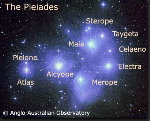 |
were genetically compatible with us and had been visiting Earth in past scores of thousands of years. Some 10,000 or so years ago they decided to oversee us in a manner that no longer involved themselves directly, and to give us some guidance in a similar indirect manner. This they did by arranging to have a highly advanced spirit form or soul periodically reincarnate into the human race in the Middle East region, starting with the biblical Enoch. Some 3000 years ago they decided the time was approaching when the key human lifetime of this spirit form should occur, for the purpose of teaching humanity some spiritual truths. So some 2000 years ago they brought about this incarnation, with that spirit form reincarnating into the fetus of Jmmanuel around A.D. 6, not 6 B.C.! His alien procreator saw to it that Jmmanuel would receive intensive education in his youth, which involved those "lost years of Jesus" spent in India -- a topic receiving very substantial evidential support. Thus Jmmanuel was an occasional contactee of these aliens. They realized that his teachings would inevitably be distorted, but felt that mankind could only learn through making mistakes and then learning from those mistakes. So they maintained a continued interest over the centuries.
One of the TJ's minor heresies is that the person who betrayed Jmmanuel to the arresting party and a little later committed suicide was Juda Ihariot, a young Pharisee who had been acquainted with Jmmanuel and the disciples, and not Judas Iscariot. Judas was Jmmanuel's designated writer as well as the treasurer for the twelve.
However, the greatest of the TJ's heresies is that Jmmanuel survived the crucifixion, with the help of medical attention inside the tomb during three days and nights. Then, after appearing to his disciples several times, he went on to Damascus where he stayed incognito a couple years, before sending for his mother Mary, brother Judas (Judas Thomas) and disciple Judas Iscariot to join him. Soon thereafter they started on their travels, of which various traditions speak.
The TJ rolls were mostly written by Judas Iscariot who traveled with Jmmanuel to India, along with Judas-Thomas (Jmmanuel's brother Judas) and mother Mary, several years after the crucifixion. However, the full story was only completed in India in the early second century, with a transcription of the rolls apparently having been penned there. After Jmmanuel's eventual death in the Kashmir region in early 2nd century, the rolls and their transcription were carried back to the Palestinian or Anatolian region by Jmmanuel's oldest son. He evidently released the transcription somewhere in that region, where it eventually found its way into the hands of the writer of Matthew, but he preserved and hid the original TJ rolls within a tomb just south of the Old City of Jerusalem. There they were presumably safeguarded from premature discovery by aliens of the same group until they prompted Meier and Rashid to discover them in 1963.
Early in his Pleiadian contacts Meier asked his primary alien contactor, Semjase, if she could give him a
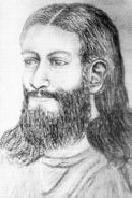 |
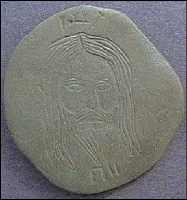 |
|
Jmmanuel as sketched by
Semjase, retouched by an artist. From the Talmud of Jmmanuel. |
"Son of the Great Spirit."
From Ancient American, Vol. 4, No. 26. |
picture of Jmmanuel. She declined, but told him that if he supplied paper and pencil (so that no alien evidence would be left behind) she would make a sketch from their records. This she did, and gave to Meier; it is shown on the left. He is seen to be young looking but bearded, with almond-shaped eyes, hair parted in the middle, a mustache and lips that are not especially prominent. These same features are seen in the picture on the right, which is an etching on a stone that came from the Burrows cave in Michigan containing various native-American artifacts. The latter did not come to public attention until 1879, and were recently dated to the 4th century A.D. or earlier (Wayne May, "Christ in America?," Ancient American, Vol. 4, No. 26 (Jan./Feb. 1999)). (The face shown in these drawings does not much resemble the one on the Shroud of Turin.) Considering that Jmmanuel was a contactee whose mission was to teach spiritual truths in many lands, we must keep open the possibility that some time after traveling to northern India and settling down there, Jmmanuel was taken on extended tours to the Americas and back in his father's UFO. See He Walked the Americas by L. Taylor Hansen (Amherst, WI: Legend Press, 1963), for Native-American legends regarding "Jesus," as influenced by Christianity in the last few centuries. Interestingly, both the stone etching and the legends indicate the man had a full beard, which Native Americans did not grow.
The TJ's text continues well into the narratives of Jmmanuel's travels in Anatolia, with interesting and practical teachings occupying much of it. Then it ends due to the written translation of the rolls that Meier received from Rashid not having extended past the point where Jmmanuel and his traveling companions were in a caravan on the road headed east to the land of India. Meier has estimated that only the translation of one of the original four rolls of writing was sent to him before their destruction in 1974. Thus, all has been lost that pertained to Jmmanuel's long life and ministry in India and Kashmir, except for what Rashid read during his initial reading of the rolls and then related to Meier, and except for what certain other traditions indicate.
What was not lost, however, includes a wealth of extremely valuable material. Among it is confirmation that Jmmanuel alias Jesus did travel to India and back during the Lost Years of his youth and early manhood. This confirms research on this topic, the most recent of which is that of Ed Martin, author of King of Travelers.
www.tjresearch.info/overview.htm
**************************************************************
DISCOVERY OF THE TALMUD OF JMMANUEL
This discovery occurred in 1963 as Swiss citizen and then world-traveler, Eduard Albert Meier, and his older friend, an ex-Greek-Orthodox priest, Isa Rashid, were walking along a roadway just south of the Old City of Jerusalem late one afternoon. Meier happened to glance up
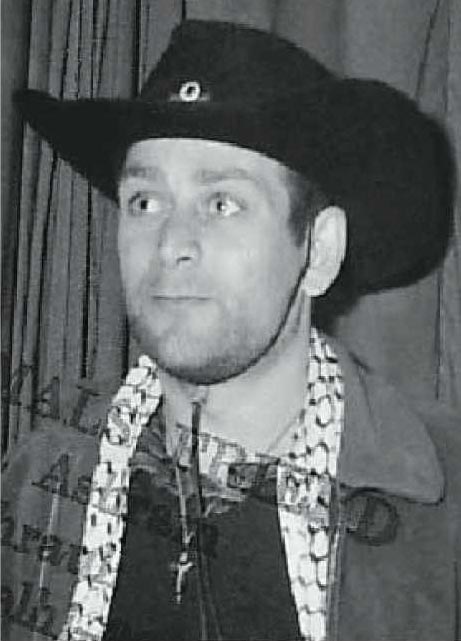 |
|
Photo of Meier in
the 30 Sept.,1964, Delhi newspaper. From FIGU Press Information |
the slope and notice a small opening in the ground amongst the rocks and shrubs. According to Meier's much later recollection in August of 1997, this hole was about 30 cm, or a foot, on a side. Being curious, he reached into his packsack for his flashlight and peered into the hole to notice that it continued inwards. So he and Rashid proceeded to dig away rocks and earth until the hole was large enough that they could crawl inside. It was an old tomb site, half filled in with earth. After further digging and exploring inside it they discovered, buried underneath a flat rock, a bundle which they took back with them to Rashid's abode; it was about 60 cm in length and 25 cm wide. The bundle turned out to contain the Talmud of Jmmanuel (or TJ) in the form of rolls of written sheets, along with a few small artifacts. They had been wrapped up together in animal skin which was in turn encased in resin, by then dry and crumbly, but recalled to have been black on the outside and yellowish-brown on the inside. There were four rolls, each of which contained many leaves or pages of Aramaic writing. They were obviously old and fragile but the writing was clearly legible. Meier recalls that each leaf was roughly 30cm by 40cm in size, or somewhat larger than the European AID A4 size of paper, which is 21cm by 29.4cm. He is not sure if they were made of very thin, translucent parchment or of papyrus.
Rashid, who could read most of the old Aramaic due to his Palestinian background on his father's side, soon noted that the TJ was heretical in several respects. For one, its title involved Jmmanuel (i.e., Immanuel, spelled with a J symbol supplying the "i" sound in place of the Aramaic/Hebrew letter "Ayin") rather than Jesus or Y'shua. For another, its writer was given as Judas Iscariot, the supposed betrayer. For a third, it mentioned that Adam's father had been Semjasa, the leader of the celestial sons, who were El's or God's guardian angels, and who were "distant travelers." Thus it was apparent from the beginning that if they wished this document ever to become public, its translation would have to proceed in secret. The Old Testament God had been an extraterrestrial leader rather than a "Father" in heaven. We shall be referring to him by his title of El, as in Immanuel.
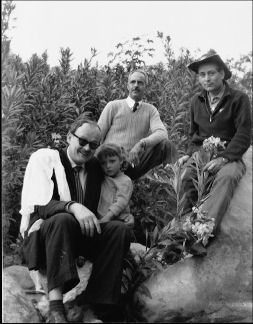 |
|
|
Isa Rashid in the rear, Meier on the right.
Photo taken in Jordan in 1963, from Plate 18 of Geheimnisse des Gemeindepfarrers by Hans Georg Lanzendorfer. |
Meier's interest in the document was very strong, as he not only had been self-schooled in earth's major religions while working his way around Asia and the Mideast, and was seeking spiritual truths, but he had been informed seven years before that he would become the disseminator of this document (more on this in the following section). Rashid spent a few months reading through the TJ rolls to glean their highlights, which he reported to Meier. Then the two agreed in August of 1963 that Rashid would translate the TJ into Meier's language (German, a language which Rashid understood) and would retain custody of the Aramaic document, while sending his translations to Meier for him to disseminate. So Rashid started the long task of rendering a translation of satisfactory quality, while Meier then continued his travels and first-hand religious learning, particularly under the Buddhist leader, V.B. Dharmawara,
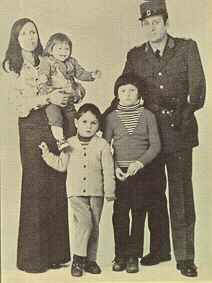 |
|
Meier and family in 1975.
Here Meier poses in his uniform as a security guard, a job he held at the time. From Wendelle Stevens' UFO Contact from the Pleiades |
at the Ashoka ashram in Mehrauli, India, working his way along through doing odd jobs. The 1964 New Delhi newspaper article about Meier can be read here. In 1965 Meier lost his left arm in a bus accident in Turkey. Later that year he met a Greek girl, Kalliope, eloped with her in 1966 and, after further working/traveling their way around Asia, returned to Switzerland to continue raising a family there and obtain employment in the town of Hinwil.
The translations up through the TJ's 36th chapter reached Meier in Switzerland through circuitous mail some time around 1970. They had been sent to the address Rashid remembered for Meier's parents. But Meier did not hear from Rashid himself until in a letter in September of 1974. This letter briefly explained that his translation project had become known to certain authorities, forcing him to flee from Jerusalem, together with his family, the TJ rolls and further translations, to a refugee camp in Lebanon. But his presence there became known to Israeli authorities, and the camp was heavily bombed, forcing him to flee again, this time to Baghdad, where he posted the letter to Meier. However, he and his family, like the other refugees, had to flee so suddenly that Rashid had no time to retrieve the Aramaic rolls or his further translations of them, and they were destroyed in the resulting conflagration.
In 1976 Meier learned that Rashid and his family were assassinated in Baghdad,
 |
 |
 |
 |
 |
| 1978 | 1992 | 1996 | 2001 | 2007 |
making him (Meier) the only known surviving witness to the TJ's discovery and historicity. About this time he started preparing the TJ translations for self-publication, and the German edition came out in 1978. A combined German-English version was published in 1992, and another edition, with improved English translation, was published in 1996 by Wild Flower Press. A further improved German-English translation, the TJ's 3rd edition, came out in November of 2001, and a 4th edition, further improved and augmented, was published in 2007 from its new publisher, Steelmark. Meier insists that publications of non-German translations of the TJ include the side-by-side German edition, so that discrepancies or distortions in translation be less likely to creep in.
Click here for links to discussions of large numbers of TJ verses having parallels within the Gospel of Matthew, along with comparative analyses of the two.
www.tjresearch.info/discovery.htm
